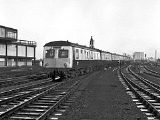
British Rail Class 120
Encyclopedia
The Class 120, were a cross-country DMU in three-car formation, built at the British Rail
Swindon Works
.
Totalling 194 cars, three batches were built:
British Railways placed the order with British United Traction in summer 1956 for the equipment required for the 98 power cars and 47 trailers of the first batch. The order, along with equipment ordered by Cravens for 66 power cars and the 3 parcels cars, was valued at £830,000. The first batch was ordered for the WR's West Country dieselisation scheme, which it hoped to complete by the end of 1959. The sets were expected to work between Bristol & South Devon. Their general reliability and good braking characteristics made them popular with drivers.
In February 1959, the BTC
placed an order with BUT for the equipment for the seven ScR sets, along with equipment for Class 108s and 127s being built at Derby. These 120s were to work mainly on the Aberdeen
to Inverness
line although appearances at Oban
were not unknown. Otherwise the cars worked mainly in the Western and Midland Regions.
Some cars had a trial refurbishment but this was found to be too expensive, meaning an early withdrawal for most of the class. Some of the London Midland Region's units were transferred to Scotland in the mid-1980s, mainly finding use on local services from Edinburgh (notably to North Berwick
). The final vehicles survived until 1989.
One trailer car survives at the Great Central Railway
.
British Rail
British Railways , which from 1965 traded as British Rail, was the operator of most of the rail transport in Great Britain between 1948 and 1997. It was formed from the nationalisation of the "Big Four" British railway companies and lasted until the gradual privatisation of British Rail, in stages...
Swindon Works
Swindon Works
Swindon railway works were built by the Great Western Railway in 1841 in Swindon in the English county of Wiltshire.-History:In 1835 Parliament approved the construction of a railway between London and Bristol. Its Chief Engineer was Isambard Kingdom Brunel.From 1836, Brunel had been buying...
.
Totalling 194 cars, three batches were built:
- 1958 - 49 sets for the Western Region
- 1959 - 7 sets for the Scottish Region
- 1961 - a further 9 sets for the Western Region
British Railways placed the order with British United Traction in summer 1956 for the equipment required for the 98 power cars and 47 trailers of the first batch. The order, along with equipment ordered by Cravens for 66 power cars and the 3 parcels cars, was valued at £830,000. The first batch was ordered for the WR's West Country dieselisation scheme, which it hoped to complete by the end of 1959. The sets were expected to work between Bristol & South Devon. Their general reliability and good braking characteristics made them popular with drivers.
In February 1959, the BTC
British Transport Commission
The British Transport Commission was created by Clement Attlee's post-war Labour government as a part of its nationalisation programme, to oversee railways, canals and road freight transport in Great Britain...
placed an order with BUT for the equipment for the seven ScR sets, along with equipment for Class 108s and 127s being built at Derby. These 120s were to work mainly on the Aberdeen
Aberdeen railway station
Aberdeen railway station is the main railway station in Aberdeen, Scotland. It is the busiest railway station in Scotland north of the major cities of Glasgow and Edinburgh.- History :...
to Inverness
Inverness railway station
Inverness railway station is the railway station serving the Scottish city of Inverness.- History :Opened on 5 November 1855 as the western terminus of the Inverness and Nairn Railway, it is now the terminus of the Highland Main Line, the Aberdeen-Inverness Line , the Kyle of Lochalsh Line and the...
line although appearances at Oban
Oban railway station
Oban railway station is a railway station serving Oban in Scotland. It is the terminus of one branch of the highly scenic West Highland Line north of . It was originally the terminus of the Callander and Oban Railway. Services are operated by First ScotRail....
were not unknown. Otherwise the cars worked mainly in the Western and Midland Regions.
Some cars had a trial refurbishment but this was found to be too expensive, meaning an early withdrawal for most of the class. Some of the London Midland Region's units were transferred to Scotland in the mid-1980s, mainly finding use on local services from Edinburgh (notably to North Berwick
North Berwick railway station
North Berwick railway station is a railway station serving the seaside town of North Berwick in East Lothian, Scotland. It is the terminus of the Edinburgh to North Berwick Line, 36 km east of .- History :...
). The final vehicles survived until 1989.
One trailer car survives at the Great Central Railway
Great Central Railway (preserved)
The Great Central Railway is a heritage railway split into two adjacent sections, one in Leicestershire and the other Nottinghamshire.The Leicestershire section is currently Britain's only double track mainline heritage railway, with of working double track, period signalling, locomotives and...
.

